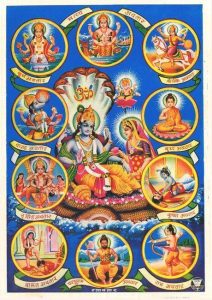Yoga’s idea of Divinity is so generous! To begin with, you are an individualized form of God, even though you may not yet know your Self so fully. In fact, everyone and everything is an individualized form of the One. Beyond that, when the universe is in need, God comes to help. Not just once, but as many times as needed. Wow!
Newly introduced to the mysteries of yoga, this idea clashed with what I had been taught — that God incarnated only once, thousands of years ago, and I missed the chance to meet him. As a pre-teen, this made me angry. I would have wanted to live 2,000 years ago!
As I got to know the teachings more fully, and as I observed and benefitted from my Guru, a Divine Human himself, my mind and heart expanded to embrace all forms of Divinity. What a benevolent God, who will incarnate to help us as many times as needed. I love it!
Dashavataras: Ten Incarnations of Vishnu
Whenever dharma, the inherent order of the universe, is endangered, God comes to rescue us. Lord Vishnu is the one who serves as our Protector and Sustainer. He promises to incarnate into this world to reinstate dharma, to protect and to destroy evil and reinstate righteousness.
Unfortunately, there have been many times that we needed such Divine intervention. Of His numerous avatars (incarnations), ten are mainly for the purpose described above, so they are called the Dashavataras (das = 10). According to the Puranas, nine of them have already taken come, with the tenth to come at the end of this age (called Kali Yuga).
- Matsya – the fish
- Kurma – the tortoise
- Varaha – the boar
- Narasimha – the part-human/part-lion
- Vamana – a dwarf human
- Parashurama – a human warrior with an axe
- Rama – a prince and king
- Balarama – the elder brother of Krishna
- Krishna – a prince and king, alongside his elder brother Balarama
- Kalki – on a white horse, with a powerful sword.
In some areas of India, Gautama Buddha (Siddhartha Gautama) is honored instead of Balarama.
The orders in which these avatars came is similar to the theory of evolution:
- Matsya – a fish is the first class of vertebrates (or life form itself) in water, Silurian Period
- Kurma – amphibious, Devonian Period
- Varaha – a mammal, a wild land animal, Triassic Period
- Narasimha – part-human/part-animal, an uncivilized wild-natured human being
- Vamana – the dwarf human, one of the early humans
- Parashurama – the angry human, early humans living in forests and using weapons
- Rama – the perfect human, a human living in community, at the beginning of civil society
- Balarama – a human in a politically advanced society, but rife with corruption.
- Krishna – the divine statesman, in politically advanced societies but with corruption
- Kalki – the mighty warrior, in a time of advanced beings with great powers that will lead to the destruction of the world.
This blog is an introduction to a series telling the stories of each of these avatars. Some of these avatars have a lot of information available about them, while some have less. Therefore the length of the stories will vary accordingly. Swami Nirmalananda says, “They each bring important lessons, to help you in your process of spiritual upliftment, the discovery of the inner mystery of your inherent Divinity.”


